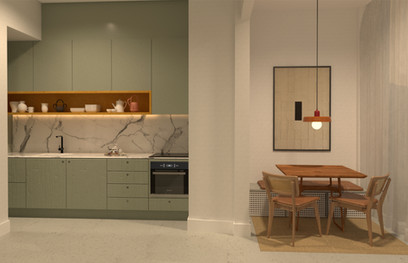The 5 Pillars of Sustainable Interior Design You Must Know
- itsk.studio team

- Jan 3
- 4 min read
Updated: Sep 23
As the world becomes increasingly aware of the environmental impact of human activities, sustainable interior design has gained significant traction in recent years. This holistic approach to designing spaces focuses on minimising the ecological footprint and creating healthier environments for occupants. Sustainable interior design encompasses a variety of practices and principles aimed at reducing waste, using eco-friendly materials, and promoting energy efficiency.
Today, we will explore the pillars of sustainable interior design to help you better understand what it takes to create such a design:
Pillar 1. Materials and Resources
The first pillar of sustainable interior design is the careful selection of materials and resources used in the construction and decoration of spaces. This involves considering the lifecycle of materials, their environmental impact, and their contributions to indoor air quality. Sustainable interior designers prioritise the use of:
Recycled and reclaimed materials: By reusing materials such as reclaimed wood, recycled metal, and repurposed furniture, we can reduce the demand for new resources and minimise waste.
Renewable and sustainable materials: Natural materials like bamboo, cork, and wool come from rapidly renewable sources and have a lower ecological impact compared to non-renewable options like plastics.
Low VOC (Volatile Organic Compounds) and non-toxic materials: By choosing materials and finishes that emit fewer harmful chemicals, we can improve indoor air quality and reduce the risk of health issues for occupants.
Pillar 2. Energy Efficiency
The second pillar of sustainable interior design focuses on reducing energy consumption and promoting the use of renewable energy sources. This can be achieved through various strategies, such as:
Incorporating energy-efficient lighting: LED and CFL bulbs consume significantly less energy and have a longer lifespan than traditional incandescent bulbs, reducing both energy consumption and waste.
Implementing passive design elements: Sustainable interior designers can optimise natural light and ventilation through strategic window placement, shading devices, and the use of reflective surfaces.
Utilising energy-efficient appliances and systems: Investing in Energy Star-rated appliances, programmable thermostats, and energy-efficient heating and cooling systems can significantly reduce energy consumption and lower utility bills.
Pillar 3. Water Conservation
Sustainable interior design also involves minimising water usage and promoting water conservation. This can be achieved by:
Installing low-flow fixtures: Low-flow faucets, showerheads, and toilets can significantly reduce water consumption without sacrificing performance.
Incorporating water-saving appliances: Energy Star-rated dishwashers and washing machines use less water while maintaining efficiency.
Utilising greywater systems: Greywater recycling systems collect and treat wastewater from sinks, showers, and washing machines for reuse in irrigation or toilet flushing, reducing the demand for potable water.
Pillar 4. Indoor Environmental Quality
A key aspect of sustainable interior design is creating healthy, comfortable, and productive living and working environments. This can be achieved by:
Ensuring proper ventilation: Adequate ventilation can help reduce indoor air pollutants and maintain a comfortable temperature.
Using natural and low-VOC materials: As mentioned earlier, choosing materials that emit fewer harmful chemicals can improve indoor air quality.
Incorporating biophilic design elements: Integrating natural elements such as plants, natural light, and natural materials can promote well-being and improve indoor environmental quality.
Pillar 5. Social Responsibility
Finally, sustainable interior design considers the social and ethical aspects of design decisions. This includes:
Supporting local businesses and artisans: By sourcing materials, products, and services from local suppliers, sustainable interior designers can promote local economies and reduce transportation-related emissions.
Ensuring fair labour practices: Sustainable interior designers should prioritise working with companies that adhere to ethical labour practices and promote worker welfare.
Embracing inclusivity and accessibility: Designing spaces that are accessible and welcoming to people of all abilities and backgrounds is an essential component of sustainable interior design.
Conclusion
Sustainable interior design is a holistic approach to creating eco-friendly spaces that minimise environmental impact and promote occupant well-being. By focusing on the pillars of materials and resources, energy efficiency, water conservation, indoor environmental quality, and social responsibility, sustainable interior design can help create a healthier, more sustainable future for all. So, keep these pillars in mind the next time you design your next interior.
itsk.studio is your go-to property agency, offering various services from property hunting down to home renovations. If you are looking for Lisbon interior design services.
Who is itsk.studio?
itsk.studio is a premier boutique property and design agency based in Lisbon, founded by Belgian designer Kurt de Leeuw in 2017. Supported by a globally-inspired team, we guide clients through every stage of their home journey, from property acquisition to bespoke interior design.
We offer specialized property hunting and buyer agent services, ensuring clients find the perfect home that aligns with their vision and lifestyle. Our team meticulously researches and selects properties with strong investment potential, prioritizing locations that offer both aesthetic appeal and sustainable living options
Our design philosophy is minimalist eclectic, combining avant-garde style with a deep commitment to sustainability. We prioritize eco-friendly materials and energy-efficient solutions, creating spaces that are both visually stunning and environmentally responsible, reflecting our dedication to crafting beautiful, planet-friendly homes.











Comments